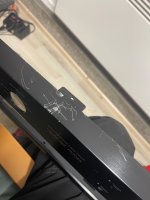I've got a few older ES amps too, a couple with much smaller 'dinks' on that top surface (& edge) of the front panels - those are indeed quite well 'disguised' using black 'Sharpie' type marker pens, albeit dependant upon lighting etc. Your scratches however are much deeper, and more extensive, a Sharpie is not going to hide those very well...
I'd be inclined to mask off the rest of the panel, and just work only on the scratched flat top part (and edge), rub it down lightly everywhere just to provide a better 'key' for paint, and then spray it with several coats of a filler-primer, to build filler into the scrathes, rubbing down regularly between coats to keep everything more or less flat. Once the scrathes are 'filled', switch to a suitable black finish.
The final top coat is unlikely to be a perfect match to the front face, but if you get close, you'll be the only one who notices, especially if the new paint comes cleanly up to the new / old edge.
I'd be inclined to mask off the rest of the panel, and just work only on the scratched flat top part (and edge), rub it down lightly everywhere just to provide a better 'key' for paint, and then spray it with several coats of a filler-primer, to build filler into the scrathes, rubbing down regularly between coats to keep everything more or less flat. Once the scrathes are 'filled', switch to a suitable black finish.
The final top coat is unlikely to be a perfect match to the front face, but if you get close, you'll be the only one who notices, especially if the new paint comes cleanly up to the new / old edge.
There is some touch up products used for anodizing that work pretty well. They are longer lasting than marker which often turns purple after some time.
https://caswellcanada.ca/product/anodize-touch-up-kit/
https://caswellcanada.ca/product/anodize-touch-up-kit/
A different but radical approach applicable to many metal devices: sand off sharp edges of the scratches. Check surface, sand again in finer grid and sand away all text too. Remove anything plastic and remove buttons. Bring to powder coater and have it coated in satin black. If you care about text then it could be engraved before coating. Instead of text undeeply drilled dots also work out OK. This technique will give a new like appearance but of course without gold lettering. I prefer that over severe scratches and possible aluminium corrosion. I had some severe damages in aluminium in the past that were practically invisible after power coating. Another good thing IMHO is that you can choose to have the device completely in another color unusual in audio like grey tints. Issue is that painted surfaces have to be sand blasted before coating and sandblasting is more expensive that the coating. I have several devices in unusual (but industry standard) satin colors and it works out pretty well. High gloss is tacky and fingerprint sensitive and matte does not work out that well IMO. There is another possibility to leave out "useless" or error prone functionality (speaker A/B) and cover the front with a new aluminium sheet tightened with 4 x M3 or M4 stainless steel bolts and only holes for the functions you will use like power on/off, source selection and volume control and have it then coated.
The coater here uses many grey tints varying from anthracite to light grey on a daily basis, a few white variants and only rarely black (if one has patience) so that costs not much if one gives stuff to coat.
There is no real trick repairing such damage (unfortunately) and it annoys when one likes the device hence my radical approach. Spray paint is inadequate except the stuff on epoxy basis but it is hard to apply in even layers.
The coater here uses many grey tints varying from anthracite to light grey on a daily basis, a few white variants and only rarely black (if one has patience) so that costs not much if one gives stuff to coat.
There is no real trick repairing such damage (unfortunately) and it annoys when one likes the device hence my radical approach. Spray paint is inadequate except the stuff on epoxy basis but it is hard to apply in even layers.
Last edited:
